Introduction to Six sigma
Download as ppt, pdf2 likes968 views
Six Sigma is a data-driven methodology for eliminating defects in any process. It aims to achieve a goal of 3.4 defects per million opportunities. The key concepts of Six Sigma revolve around critical quality attributes, defects, process capability, and variation. There are two main methodologies - DMAIC for improving existing processes and DMADV for designing new processes. Both follow the five steps of Define, Measure, Analyze, Improve/Design, and Control/Verify. Implementing Six Sigma requires roles like Champions, Master Black Belts, Black Belts, and Green Belts.
1 of 24
Downloaded 75 times



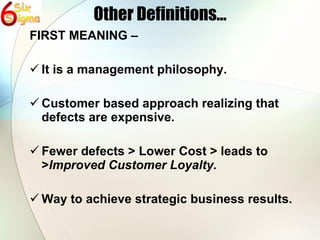
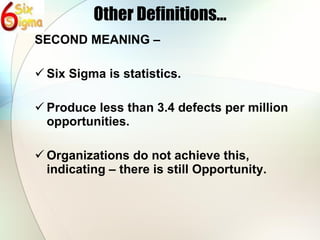

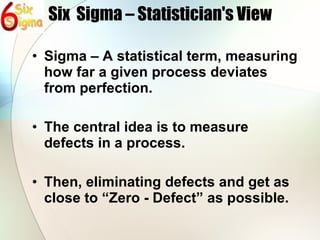
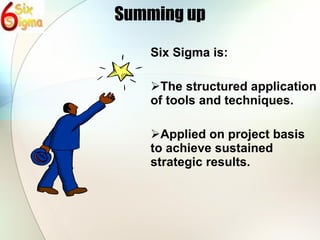
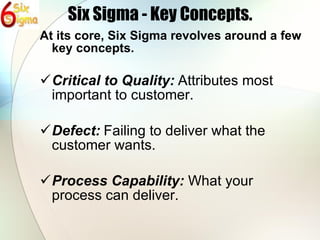
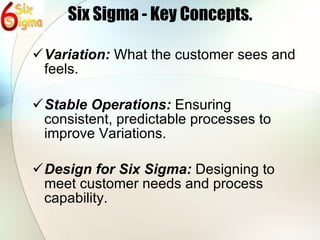
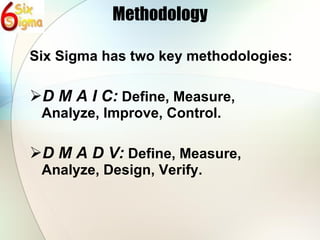
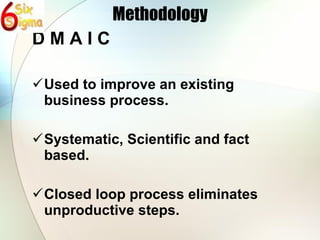
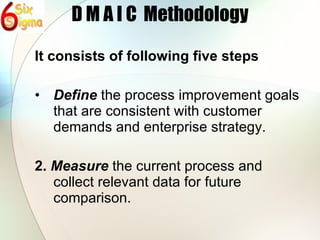
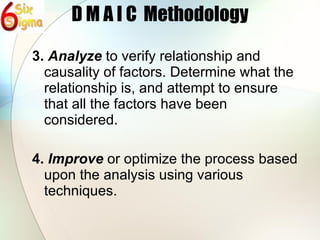

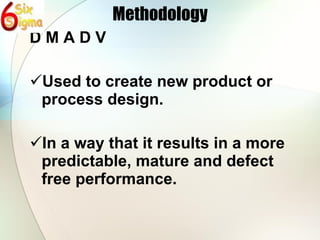

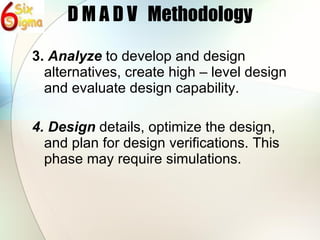

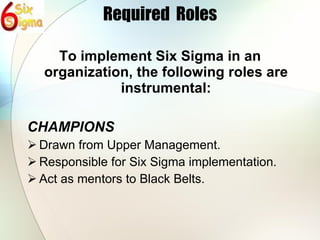
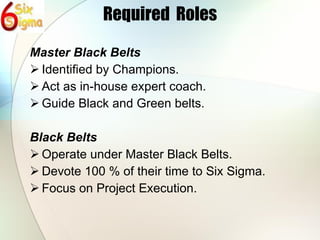



Ad
Recommended
Adi Six sigma basics
Adi Six sigma basicsaditi Saxena
╠²
Six Sigma is a data-driven methodology for eliminating defects in any process. It aims to achieve near-perfect quality by producing no more than 3.4 defects per million opportunities. There are two key methodologies in Six Sigma: DMAIC for improving existing processes, and DMADV for designing new processes. Successful implementation requires specific roles like Champions, Master Black Belts, Black Belts, and Green Belts.Basics Six Sigma Fresher Guide
Basics Six Sigma Fresher GuideNeetu Maltiar
╠²
This document provides an overview of Six Sigma, a disciplined process focusing on improving quality by reducing defects to less than 3.4 per million opportunities. It outlines key concepts such as critical to quality, defect, and process capability, along with two primary methodologies: DMAIC for improving existing processes and DMADV for new product design. Additionally, it describes the roles required for Six Sigma implementation, including champions, master black belts, black belts, and green belts.Six sigma dmaic approach
Six sigma dmaic approachSiddhartha Harit
╠²
Six Sigma is a methodology focused on continuous improvement in customer satisfaction and profitability through the elimination of waste and inefficiency. Originating at Motorola in the 1980s, it emphasizes structured methodologies, data-driven decision-making, and employee involvement for enhancing process capabilities and lowering defects. The approach utilizes the DMAIC and DMADV frameworks to define, measure, analyze, improve, and control processes to meet and exceed customer expectations.Lean Six Sigma Black Belt Training Part 1
Lean Six Sigma Black Belt Training Part 1Lean Insight
╠²
The document outlines a Six Sigma Black Belt training program in Bangalore, emphasizing the importance of quality in business and the benefits of Six Sigma certification for career advancement. Participants will learn key principles and the DMAIC process to lead improvement projects effectively. The historical context of Six Sigma's implementation by companies like Motorola and GE highlights its significant impact on cost savings and process improvements.DMAIC Methodology
DMAIC MethodologyLean6Sigma4all
╠²
Lean Six Sigma is a methodology that uses the DMAIC (Define, Measure, Analyze, Improve, Control) process to systematically identify and eliminate waste and defects. It involves selecting projects with known problems and potential for improvement. The DMAIC process first defines the problem and goals, then measures key aspects, analyzes data to find root causes, improves the process by addressing causes, and controls the new process to hold gains.Presentation on six╠²sigma roles
Presentation on six╠²sigma rolessatya pal
╠²
Six Sigma is a statistical methodology for improving processes by reducing defects to 3.4 defects per million opportunities. It follows the DMAIC process of define, measure, analyze, improve, and control. Key roles in Six Sigma implementation include Executive Leadership to provide vision, Champions to oversee implementation, Master Black Belts as expert coaches, Black Belts to lead projects applying the methodology, Green Belts to support projects, and Process Owners responsible for targeted business processes.Six Sigma presentation
Six Sigma presentationShikha Singh
╠²
Six Sigma is a methodology for continuous improvement that aims to reduce process variation. It was developed by Bill Smith at Motorola in 1986 and focuses on eliminating defects through statistical analysis and process improvement techniques. The goal is 3.4 defects per million opportunities. Six Sigma uses DMAIC (Define, Measure, Analyze, Improve, Control) as its core problem-solving methodology. It can be integrated with project management processes and tools to help define requirements, manage risks and optimize processes.Six sigma
Six sigmaMOHD ARISH
╠²
Six Sigma is a data-driven methodology for improving processes by reducing variability. It was developed by Motorola in the 1980s and aims for near perfect processes with fewer than 3.4 defects per million opportunities. The Six Sigma methodology uses statistical tools and involves defining problems, measuring processes, analyzing data, improving processes, and controlling them. It focuses on customer satisfaction and uses roles like Black Belts, Green Belts, and Master Black Belts. Many large companies have implemented Six Sigma and achieved savings of 1-4.5% of revenue through reduced costs and improved quality.Basics of Six Sigma
Basics of Six SigmaHarishankar Sahu
╠²
This document discusses Six Sigma, which aims to reduce variability in business processes. It defines Six Sigma as a statistical term representing 3.4 defects per million opportunities. The document outlines the benefits of Six Sigma, such as generating sustained success, enhancing customer value, and accelerating improvement. It also describes the DMAIC methodology, which is a five-step approach for process improvement involving Define, Measure, Analyze, Improve, and Control phases.iACT Global | DMAIC Methodology
iACT Global | DMAIC MethodologyiACT Global
╠²
Six Sigma is a widely used business management strategy designed to eliminate defects in processes, utilizing quality management methods and a structured infrastructure of trained professionals. The document outlines the DMAIC methodology, a five-phase approach (Define, Measure, Analyze, Improve, Control) essential for Six Sigma projects, providing a clear overview of each phase's objectives and activities. IACT Global offers training and certification in Six Sigma, emphasizing its potential benefits for organizations.Six Sigma
Six SigmaChirag Swamy
╠²
Six Sigma is a set of process improvement techniques and tools used to reduce variability and increase profits through statistical quality control. It aims to enhance customer satisfaction and product quality. Key methodologies for implementing Six Sigma include DMAIC, which follows the plan-do-check-act cycle to define problems, measure metrics, analyze root causes, improve processes, and control results. DMADV is used for developing new processes and products. Both draw on techniques like FMEA, DOE, control plans and more. Six Sigma benefits organizations through lower costs, fewer defects, and stronger business performance.Six Sigma Vocabulary List
Six Sigma Vocabulary ListMersedeh Arvaneh
╠²
This document defines key terms and concepts related to Six Sigma, including:
- DMAIC and DMADV, which are problem-solving frameworks for improving processes.
- Lean Six Sigma, which integrates Six Sigma methodology with Lean techniques.
- Roles like Black Belts, Green Belts, Champions and Master Black Belts who lead Six Sigma projects.
- Metrics like Sigma levels and defects per million opportunities (DPMO).
- Tools like MINITAB software and balanced scorecards.Lean Six Sigma Black Belt Training Part 5
Lean Six Sigma Black Belt Training Part 5Lean Insight
╠²
This document discusses Lean Six Sigma training and customer needs analysis tools. It explains COPIS (Customers, Outputs, Processes, Inputs, Suppliers), which is used to map customer requirements and how a process delivers outputs. The document also outlines the key elements of a project charter, including the business case, problem statement, project scope, team, timelines, and communication plan. The charter defines the purpose and intended outcomes of a project.Six sigma
Six sigmaMohammad Deen
╠²
Six Sigma is a methodology that aims to reduce defects and improve quality by identifying and removing the causes of errors and minimizing variability in manufacturing and business processes. The key aspects are:
- It uses a "sigma level" scale to measure quality, with higher sigma indicating fewer defects. Six Sigma seeks to operate with no more than 3.4 defects per million opportunities.
- There are two main approaches - DMAIC focuses on improving existing processes, while DMADV is for designing new processes and products.
- Organizations implement Six Sigma through teams of Champions, Master Black Belts, Black Belts, Green Belts and Yellow Belts at different levels who lead projects and train others in the methodology.What is Six Sigma?,
What is Six Sigma?,Rahul Boddul
╠²
Six Sigma is a quality improvement methodology developed by Motorola, focused on eliminating defects to achieve 99.9997% defect-free processes and products. It utilizes a data-driven approach with the DMAIC framework (Define, Measure, Analyze, Improve, Control) and emphasizes continuous improvement, organizational commitment, and measuring performance to enhance business processes. While the methodology offers advantages such as increased customer satisfaction and improved profitability, challenges include a lack of interest in statistical aspects among some engineers and communication barriers between statisticians and management.Six Sigma[1]
Six Sigma[1]Vishal Wadekar
╠²
The document discusses Six Sigma, a methodology used to improve quality and reduce defects. It explains what Six Sigma is, the key methodologies of DMAIC and DMADV, why companies implement it, the different belts within Six Sigma, and why it is preferred over total quality management. It also covers the Altman Z-Score, which uses financial ratios to predict the likelihood of bankruptcy, walking through an example calculation and interpretation. Finally, it briefly introduces the topics of virtuous and vicious business cycles.SIX SIGMA PRESENTATION
SIX SIGMA PRESENTATIONObalashi Rajani
╠²
This document provides an overview of Six Sigma, including definitions of key terms, methodology, roles, and benefits. Six Sigma is a data-driven methodology for improving processes by minimizing defects. It uses a define-measure-analyze-improve-control process and statistical tools to help organizations enhance customer satisfaction and increase profits by reducing variation. Key roles include Champions, Master Black Belts, Black Belts and Green Belts who work on projects of varying scope to improve critical business processes. Widespread company use of Six Sigma has resulted in significant quality and financial gains.Six sigma tools
Six sigma toolsSuparnaR1
╠²
Six Sigma is a set of techniques and tools for process improvement that seeks to reduce defects and variability. It uses statistical methods and creates experts within an organization. Six Sigma projects follow defined steps and have targets like reducing costs and increasing customer satisfaction. Some common Six Sigma tools include DMAIC (define, measure, analyze, improve, control), 5S, identifying seven wastes, value stream mapping, ensuring flow without stoppages, using visual displays, and capturing the voice of the customer. Henry Harvin provides training on Lean Six Sigma and certification.Six sigma
Six sigmanaresh sharma
╠²
The document provides an overview of Six Sigma, a quality management methodology. It discusses that Six Sigma was introduced by Bill Smith at Motorola in 1986 and later adopted by Jack Welch at GE. Six Sigma aims to improve quality by identifying and removing defects. It uses statistical methods and creates a infrastructure of experts within organizations. A six sigma process produces no more than 3.4 defects per million opportunities. The document outlines the Six Sigma project methodologies DMAIC and DMADV and roles like Champions, Master Black Belts, Black Belts and Green Belts. It provides an example of how Ford implemented Six Sigma, saving $300 million through projects following the DMAIC cycle.Six sigma
Six sigmaPriya Tiwari
╠²
Six sigma is a statistical approach to process improvement originally developed by Motorola in the 1980s. It aims to identify and remove defects in manufacturing and business processes by lowering variation in processes and producing products that meet customer specifications. Key aspects involve defining a project, measuring the current process, analyzing data to determine causes of defects, improving the process based on findings, and controlling to maintain improvements. Six sigma has been implemented by many companies globally and across industries to reduce costs and increase profits through higher quality and customer satisfaction.What is Six Sigma?
What is Six Sigma?Benchmark Six Sigma
╠²
Six Sigma is a business methodology that focuses on improving processes by reducing defects through measurement and data-driven analysis. It uses a set of tools and techniques such as statistical analysis and the DMAIC process (Define, Measure, Analyze, Improve, Control) to help organizations transition from relying on intuition to using statistical analysis to improve quality, reduce costs, and increase customer satisfaction. Many organizations across industries have implemented Six Sigma as part of their quality management system to drive success.Six sigma dmaic strategy
Six sigma dmaic strategyMohit Singla
╠²
The document discusses the Six Sigma DMAIC strategy which involves 5 phases - Define, Measure, Analyze, Improve, and Control. Each phase is designed to systematically design and execute Six Sigma projects and incorporate their results into day-to-day business operations. Six Sigma can be applied at the business, operations, and process levels to improve profitability, reduce costs, and increase customer satisfaction.Six Sigma - Benefits to Individuals
Six Sigma - Benefits to IndividualsBenchmark Six Sigma
╠²
Six Sigma training provides significant benefits to individuals in their careers. It develops business, analytical, leadership and problem solving skills. Past participants who have undergone Six Sigma training report fast career growth into leadership roles with increased responsibilities and impactful projects. They also gain soft skills and can apply Six Sigma thinking across different industries. Excerpts from interviews with Six Sigma practitioners demonstrate career progression into roles with higher visibility and ability to deliver tangible business benefits due to Six Sigma expertise.Six sigma
Six sigmaKhaled Mosharraf
╠²
The document discusses Six Sigma, a data-driven methodology aimed at quality improvement in organizations, initially introduced by Motorola in the 1980s. It outlines various strategies, tools, and methodologies involved in Six Sigma, such as DMAIC and DMADV, as well as its application in software development, addressing the benefits and challenges associated with its implementation. A case study illustrates the integration of Six Sigma principles into a job portal project, highlighting improvements in system performance and user experience.Introduction To Six Sigma
Introduction To Six Sigmamakarand_lotankar
╠²
- Motorola developed the concept of Six Sigma in 1987 to improve quality standards and reduce defects.
- Six Sigma aims to reduce defects to 3.4 defects per million opportunities by focusing on statistical process control and reducing variation. It was later adopted by other companies like GE.
- The key purpose of Six Sigma is to make customers happier by meeting their requirements and reducing defects, while also increasing company profits through cost savings from quality improvements.The DMAIC process
The DMAIC processaamir kamal
╠²
The document discusses the DMAIC process used in Lean Six Sigma. It begins by defining Lean Six Sigma and explaining that DMAIC is the methodology used, consisting of five phases: Define, Measure, Analyze, Improve, and Control. Each phase of DMAIC is then described in detail. The Define phase involves defining the problem and goals. Measure involves collecting baseline data. Analyze reviews the data to identify root causes. Improve develops solutions. Control focuses on sustaining improvements. In conclusion, the document covers when and how to use DMAIC for root cause analysis of problems.Six Sigma
Six SigmaBaibhav Agrawal
╠²
The document provides an introduction to Six Sigma, detailing its history, methodology, and application across various sectors. Originating from Motorola in the late 1970s, Six Sigma aims to improve business processes by reducing defects and enhancing customer satisfaction. The presentation also highlights the significant financial benefits realized by companies implementing Six Sigma techniques.Presentation introduction to six sigma
Presentation introduction to six sigmajpanchpor
╠²
This document provides an introduction to Six Sigma, including an overview of what it is, why it's used, key concepts like defects per million opportunities (DPMO) at different sigma levels, and the DMAIC methodology involving define, measure, analyze, improve, and control phases. It also outlines some common Six Sigma tools and roles like Green Belts, Black Belts, Master Black Belts, Champions, and executive leadership. The goal of Six Sigma is to improve quality, reduce defects and variation in processes, and increase customer satisfaction.Stress management
Stress managementNeetu Maltiar
╠²
The document discusses stress management by defining stress as the body's reaction to perceived threats or changes, known as stressors. It provides a series of reflective questions to assess one's stress level and indicates a scoring system for burnout risk. Additionally, it offers strategies for managing stress, including maintaining a positive attitude, exercising, and developing new skills.Quantas vidas você quer mudar dessa vez?AIESEC Belo Horizonte
╠²
O documento resume os programas de interc├ómbio da AIESEC Brasil em Belo Horizonte, incluindo requisitos, dura├¦├Żo e ├Īreas de atua├¦├Żo dos programas de estudos, trabalho e voluntariado. Ele tamb├®m fornece instru├¦├Ąes sobre como divulgar os programas para ajudar a cumprir as metas de transforma├¦├Żo de vidas.More Related Content
What's hot (20)
Basics of Six Sigma
Basics of Six SigmaHarishankar Sahu
╠²
This document discusses Six Sigma, which aims to reduce variability in business processes. It defines Six Sigma as a statistical term representing 3.4 defects per million opportunities. The document outlines the benefits of Six Sigma, such as generating sustained success, enhancing customer value, and accelerating improvement. It also describes the DMAIC methodology, which is a five-step approach for process improvement involving Define, Measure, Analyze, Improve, and Control phases.iACT Global | DMAIC Methodology
iACT Global | DMAIC MethodologyiACT Global
╠²
Six Sigma is a widely used business management strategy designed to eliminate defects in processes, utilizing quality management methods and a structured infrastructure of trained professionals. The document outlines the DMAIC methodology, a five-phase approach (Define, Measure, Analyze, Improve, Control) essential for Six Sigma projects, providing a clear overview of each phase's objectives and activities. IACT Global offers training and certification in Six Sigma, emphasizing its potential benefits for organizations.Six Sigma
Six SigmaChirag Swamy
╠²
Six Sigma is a set of process improvement techniques and tools used to reduce variability and increase profits through statistical quality control. It aims to enhance customer satisfaction and product quality. Key methodologies for implementing Six Sigma include DMAIC, which follows the plan-do-check-act cycle to define problems, measure metrics, analyze root causes, improve processes, and control results. DMADV is used for developing new processes and products. Both draw on techniques like FMEA, DOE, control plans and more. Six Sigma benefits organizations through lower costs, fewer defects, and stronger business performance.Six Sigma Vocabulary List
Six Sigma Vocabulary ListMersedeh Arvaneh
╠²
This document defines key terms and concepts related to Six Sigma, including:
- DMAIC and DMADV, which are problem-solving frameworks for improving processes.
- Lean Six Sigma, which integrates Six Sigma methodology with Lean techniques.
- Roles like Black Belts, Green Belts, Champions and Master Black Belts who lead Six Sigma projects.
- Metrics like Sigma levels and defects per million opportunities (DPMO).
- Tools like MINITAB software and balanced scorecards.Lean Six Sigma Black Belt Training Part 5
Lean Six Sigma Black Belt Training Part 5Lean Insight
╠²
This document discusses Lean Six Sigma training and customer needs analysis tools. It explains COPIS (Customers, Outputs, Processes, Inputs, Suppliers), which is used to map customer requirements and how a process delivers outputs. The document also outlines the key elements of a project charter, including the business case, problem statement, project scope, team, timelines, and communication plan. The charter defines the purpose and intended outcomes of a project.Six sigma
Six sigmaMohammad Deen
╠²
Six Sigma is a methodology that aims to reduce defects and improve quality by identifying and removing the causes of errors and minimizing variability in manufacturing and business processes. The key aspects are:
- It uses a "sigma level" scale to measure quality, with higher sigma indicating fewer defects. Six Sigma seeks to operate with no more than 3.4 defects per million opportunities.
- There are two main approaches - DMAIC focuses on improving existing processes, while DMADV is for designing new processes and products.
- Organizations implement Six Sigma through teams of Champions, Master Black Belts, Black Belts, Green Belts and Yellow Belts at different levels who lead projects and train others in the methodology.What is Six Sigma?,
What is Six Sigma?,Rahul Boddul
╠²
Six Sigma is a quality improvement methodology developed by Motorola, focused on eliminating defects to achieve 99.9997% defect-free processes and products. It utilizes a data-driven approach with the DMAIC framework (Define, Measure, Analyze, Improve, Control) and emphasizes continuous improvement, organizational commitment, and measuring performance to enhance business processes. While the methodology offers advantages such as increased customer satisfaction and improved profitability, challenges include a lack of interest in statistical aspects among some engineers and communication barriers between statisticians and management.Six Sigma[1]
Six Sigma[1]Vishal Wadekar
╠²
The document discusses Six Sigma, a methodology used to improve quality and reduce defects. It explains what Six Sigma is, the key methodologies of DMAIC and DMADV, why companies implement it, the different belts within Six Sigma, and why it is preferred over total quality management. It also covers the Altman Z-Score, which uses financial ratios to predict the likelihood of bankruptcy, walking through an example calculation and interpretation. Finally, it briefly introduces the topics of virtuous and vicious business cycles.SIX SIGMA PRESENTATION
SIX SIGMA PRESENTATIONObalashi Rajani
╠²
This document provides an overview of Six Sigma, including definitions of key terms, methodology, roles, and benefits. Six Sigma is a data-driven methodology for improving processes by minimizing defects. It uses a define-measure-analyze-improve-control process and statistical tools to help organizations enhance customer satisfaction and increase profits by reducing variation. Key roles include Champions, Master Black Belts, Black Belts and Green Belts who work on projects of varying scope to improve critical business processes. Widespread company use of Six Sigma has resulted in significant quality and financial gains.Six sigma tools
Six sigma toolsSuparnaR1
╠²
Six Sigma is a set of techniques and tools for process improvement that seeks to reduce defects and variability. It uses statistical methods and creates experts within an organization. Six Sigma projects follow defined steps and have targets like reducing costs and increasing customer satisfaction. Some common Six Sigma tools include DMAIC (define, measure, analyze, improve, control), 5S, identifying seven wastes, value stream mapping, ensuring flow without stoppages, using visual displays, and capturing the voice of the customer. Henry Harvin provides training on Lean Six Sigma and certification.Six sigma
Six sigmanaresh sharma
╠²
The document provides an overview of Six Sigma, a quality management methodology. It discusses that Six Sigma was introduced by Bill Smith at Motorola in 1986 and later adopted by Jack Welch at GE. Six Sigma aims to improve quality by identifying and removing defects. It uses statistical methods and creates a infrastructure of experts within organizations. A six sigma process produces no more than 3.4 defects per million opportunities. The document outlines the Six Sigma project methodologies DMAIC and DMADV and roles like Champions, Master Black Belts, Black Belts and Green Belts. It provides an example of how Ford implemented Six Sigma, saving $300 million through projects following the DMAIC cycle.Six sigma
Six sigmaPriya Tiwari
╠²
Six sigma is a statistical approach to process improvement originally developed by Motorola in the 1980s. It aims to identify and remove defects in manufacturing and business processes by lowering variation in processes and producing products that meet customer specifications. Key aspects involve defining a project, measuring the current process, analyzing data to determine causes of defects, improving the process based on findings, and controlling to maintain improvements. Six sigma has been implemented by many companies globally and across industries to reduce costs and increase profits through higher quality and customer satisfaction.What is Six Sigma?
What is Six Sigma?Benchmark Six Sigma
╠²
Six Sigma is a business methodology that focuses on improving processes by reducing defects through measurement and data-driven analysis. It uses a set of tools and techniques such as statistical analysis and the DMAIC process (Define, Measure, Analyze, Improve, Control) to help organizations transition from relying on intuition to using statistical analysis to improve quality, reduce costs, and increase customer satisfaction. Many organizations across industries have implemented Six Sigma as part of their quality management system to drive success.Six sigma dmaic strategy
Six sigma dmaic strategyMohit Singla
╠²
The document discusses the Six Sigma DMAIC strategy which involves 5 phases - Define, Measure, Analyze, Improve, and Control. Each phase is designed to systematically design and execute Six Sigma projects and incorporate their results into day-to-day business operations. Six Sigma can be applied at the business, operations, and process levels to improve profitability, reduce costs, and increase customer satisfaction.Six Sigma - Benefits to Individuals
Six Sigma - Benefits to IndividualsBenchmark Six Sigma
╠²
Six Sigma training provides significant benefits to individuals in their careers. It develops business, analytical, leadership and problem solving skills. Past participants who have undergone Six Sigma training report fast career growth into leadership roles with increased responsibilities and impactful projects. They also gain soft skills and can apply Six Sigma thinking across different industries. Excerpts from interviews with Six Sigma practitioners demonstrate career progression into roles with higher visibility and ability to deliver tangible business benefits due to Six Sigma expertise.Six sigma
Six sigmaKhaled Mosharraf
╠²
The document discusses Six Sigma, a data-driven methodology aimed at quality improvement in organizations, initially introduced by Motorola in the 1980s. It outlines various strategies, tools, and methodologies involved in Six Sigma, such as DMAIC and DMADV, as well as its application in software development, addressing the benefits and challenges associated with its implementation. A case study illustrates the integration of Six Sigma principles into a job portal project, highlighting improvements in system performance and user experience.Introduction To Six Sigma
Introduction To Six Sigmamakarand_lotankar
╠²
- Motorola developed the concept of Six Sigma in 1987 to improve quality standards and reduce defects.
- Six Sigma aims to reduce defects to 3.4 defects per million opportunities by focusing on statistical process control and reducing variation. It was later adopted by other companies like GE.
- The key purpose of Six Sigma is to make customers happier by meeting their requirements and reducing defects, while also increasing company profits through cost savings from quality improvements.The DMAIC process
The DMAIC processaamir kamal
╠²
The document discusses the DMAIC process used in Lean Six Sigma. It begins by defining Lean Six Sigma and explaining that DMAIC is the methodology used, consisting of five phases: Define, Measure, Analyze, Improve, and Control. Each phase of DMAIC is then described in detail. The Define phase involves defining the problem and goals. Measure involves collecting baseline data. Analyze reviews the data to identify root causes. Improve develops solutions. Control focuses on sustaining improvements. In conclusion, the document covers when and how to use DMAIC for root cause analysis of problems.Six Sigma
Six SigmaBaibhav Agrawal
╠²
The document provides an introduction to Six Sigma, detailing its history, methodology, and application across various sectors. Originating from Motorola in the late 1970s, Six Sigma aims to improve business processes by reducing defects and enhancing customer satisfaction. The presentation also highlights the significant financial benefits realized by companies implementing Six Sigma techniques.Presentation introduction to six sigma
Presentation introduction to six sigmajpanchpor
╠²
This document provides an introduction to Six Sigma, including an overview of what it is, why it's used, key concepts like defects per million opportunities (DPMO) at different sigma levels, and the DMAIC methodology involving define, measure, analyze, improve, and control phases. It also outlines some common Six Sigma tools and roles like Green Belts, Black Belts, Master Black Belts, Champions, and executive leadership. The goal of Six Sigma is to improve quality, reduce defects and variation in processes, and increase customer satisfaction.Viewers also liked (9)
Stress management
Stress managementNeetu Maltiar
╠²
The document discusses stress management by defining stress as the body's reaction to perceived threats or changes, known as stressors. It provides a series of reflective questions to assess one's stress level and indicates a scoring system for burnout risk. Additionally, it offers strategies for managing stress, including maintaining a positive attitude, exercising, and developing new skills.Quantas vidas você quer mudar dessa vez?AIESEC Belo Horizonte
╠²
O documento resume os programas de interc├ómbio da AIESEC Brasil em Belo Horizonte, incluindo requisitos, dura├¦├Żo e ├Īreas de atua├¦├Żo dos programas de estudos, trabalho e voluntariado. Ele tamb├®m fornece instru├¦├Ąes sobre como divulgar os programas para ajudar a cumprir as metas de transforma├¦├Żo de vidas.Booklet Elei├¦├Żo LCP 2012AIESEC Belo Horizonte
╠²
As elei├¦├Ąes para VP ICXc e VP OGXnc da LCP 2012 ocorrer├Żo no dia 2 de outubro ├Ās 13h na Avenida Portugal 340. Os candidatos s├Żo Matheus Faria e Marcelo Alves. A taxa de participa├¦├Żo ├® de R$20 e inclui um break e festa p├│s-elei├¦├Żo.Booklet REPLAN 2011 - AIESEC Belo HorizonteAIESEC Belo Horizonte
╠²
O evento OC Replan ocorrer├Ī nos dias 30 e 31 de Julho no Acampamento Imperial em Betim. A agenda inclui atividades de reflex├Żo e planejamento estrat├®gico. Os participantes devem pagar R$60 e levar itens de higiene, roupas quentes e de festa.Booklet Miss├Żo Writing DaysCezar Carvalho
╠²
1) O documento apresenta as informa├¦├Ąes sobre o evento Writing Days que ser├Ī realizado pela organiza├¦├Żo @BH nos dias 31 de mar├¦o e 1o de abril.
2) O evento ter├Ī como objetivo promover a motiva├¦├Żo e intera├¦├Żo entre os membros da organiza├¦├Żo.
3) As informa├¦├Ąes incluem detalhes sobre localiza├¦├Żo, transporte, programa├¦├Żo, itens a levar e n├Żo levar, e a equipe respons├Īvel pela organiza├¦├Żo do evento.Magazines analysis
Magazines analysis957844
╠²
This document analyzes the front covers and contents pages of several music magazines. It discusses design elements like color schemes, placement of images and text, and how these elements are used to attract readers and highlight key artists or articles. Common conventions across magazine covers include central prominent images of artists looking at the viewer, listing other artists to draw interest, and using puffs or highlights to promote featured stories. The analyses provide insights into visual marketing techniques in the magazine industry.Booklet Writing Days 2011.2AIESEC Belo Horizonte
╠²
O Writing Days ├® um evento de 24 horas para membros da AIESEC BH nos dias 24 e 25 de setembro no S├Łtio Sereno em Betim. O evento inclui atividades de reflex├Żo, integra├¦├Żo e uma festa tem├Ītica inspirada em contos de fadas. Os membros devem trazer roupas de cama, toalhas e fantasias para a festa.First Language Acquisition in hearing impaired children with cochlear implants
First Language Acquisition in hearing impaired children with cochlear implantsChula Seneviratne
╠²
This thesis examines first language acquisition in hearing impaired children with cochlear implants. It investigates the contributory factors towards making first language learning successful for these children, including age at implant, parental support, and degree of rehabilitation. The thesis also looks at how these children acquire their first language (Sinhala) and compares the developmental stages to models of English acquisition. Various data collection methods were used to understand the language acquisition process and the importance of factors like cochlear age and rehabilitation strategies. The goal overall is to understand how these children learn language aspects like phonology, morphology, and syntax with a cochlear implant, and what support is needed.Ideas on how to teach writingEdilene Pina
╠²
O documento discute t├®cnicas para ensinar habilidades de escrita em ingl├¬s de forma efetiva. Ele enfatiza a import├óncia de come├¦ar com textos simples e contextualizados e progredir gradualmente, ao inv├®s de focar em gram├Ītica repetitiva. Tamb├®m discute a estrutura b├Īsica de par├Īgrafos e como explic├Ī-la de maneira acess├Łvel para estudantes.Ad
Similar to Introduction to Six sigma (20)
sixsigma.pptx
sixsigma.pptxfarahehsan
╠²
Six Sigma is a set of techniques and tools aimed at process improvement. It was developed by Motorola in 1986 to reduce defects in manufacturing processes. Six Sigma seeks to improve quality by reducing variation and preventing defects. It uses a define-measure-analyze-improve-control methodology for process improvement projects. Key roles include Champions, Master Black Belts, Black Belts and Green Belts. While Six Sigma has helped many companies improve quality, some critics argue it is overused by consultants and may not achieve the benefits promised. Case studies demonstrate how Six Sigma has helped companies like LG Electronics and Catalent Pharma Solutions reduce defects and costs.Six sigma QMS
Six sigma QMS Deekshitha HS
╠²
Six Sigma is a quality management methodology focused on process improvement through the reduction of defects and variability, aiming for 3.4 defects per million opportunities. It involves a disciplined approach driven by customer needs and statistics, utilizing tools like DMAIC and DMADV for process improvement and product design. Developed by Motorola in the mid-1980s, Six Sigma has been adopted by many companies worldwide to enhance quality and efficiency.Six Sigma .pdf
Six Sigma .pdfSiddhiShrigiriwar
╠²
The document presents an overview of the Six Sigma concept, detailing its definition, methodologies (DMAIC and DMADV), objectives, and various applications, especially in improving processes and customer satisfaction. It highlights the roles of different levels of professionals involved in Six Sigma implementation, such as black belts and green belts, and discusses its benefits and challenges. The document emphasizes Six Sigma's importance in enhancing product quality and reducing defects through a data-driven approach.6sigma
6sigmaAntony Raj
╠²
The document discusses the history and methodology of Six Sigma. It began at Motorola in the 1980s to reduce defects in manufacturing processes. General Electric popularized it further in the 1990s. Six Sigma uses statistical methods and aims for near-zero defect rates. It certifies practitioners as Yellow Belts, Green Belts, Black Belts and Master Black Belts. Common project methodologies are DMAIC for improvement and DMADV for new product design. The document also provides case studies of Six Sigma implementation at Samsung and LG Electronics which achieved significant quality and cost improvements.Six sigma.pptx
Six sigma.pptxGulaHangus
╠²
Six Sigma is a methodology that aims to improve processes and minimize defects. It uses a data-driven approach called DMAIC (Define, Measure, Analyze, Improve, Control) to identify and address sources of variation. The goal of Six Sigma is to achieve nearly perfect processes with fewer than 3.4 defects per million opportunities. It was developed by Motorola to improve quality and has since been widely adopted. Key aspects of Six Sigma include defining problems, measuring processes, analyzing sources of variation, improving processes, and controlling improvements.Six sigma.pptx
Six sigma.pptxGulaHangus
╠²
Six Sigma is a methodology that aims to improve processes and minimize defects. It uses a data-driven approach called DMAIC (Define, Measure, Analyze, Improve, Control) to identify and address sources of variation. The goal of Six Sigma is to achieve nearly perfect processes with fewer than 3.4 defects per million opportunities. It was developed by Motorola to improve quality and has since been widely adopted. Key aspects of Six Sigma include defining problems, measuring processes, analyzing sources of variation, improving processes, and controlling improvements.Six sigma control in total quality management copy
Six sigma control in total quality management copyVijay Vuriti
╠²
This document provides an overview of Six Sigma and its role in Total Quality Management. Six Sigma is a data-driven approach to process improvement that aims to reduce defects to 3.4 per million opportunities. It uses statistical methods like DMAIC to define problems, measure processes, analyze data, improve processes, and control variables. Six Sigma projects can generate cost savings of 5-20% annually while improving quality, reducing cycle times, and developing employee skills. However, they also require costs for training, consulting, improvements, and software tools.Six sigma
Six sigmaDaniel Ilunga
╠²
Six Sigma, developed by Motorola in the 1980s, is a data-driven methodology aimed at eliminating defects and achieving near-perfection in business processes, requiring that processes not produce more than 3.4 defects per million opportunities. The methodology includes two primary approaches: DMAIC for improving existing processes and DMADV for designing new high-quality products, focusing on continuous quality improvement. While beneficial for enhancing quality across various business facets, the implementation of Six Sigma may not be suitable for all organizations, particularly smaller ones with simpler processes.sixsigma-
sixsigma-ahmadraza55629
╠²
Six Sigma is a data-driven methodology for improving processes and reducing defects that was developed by Motorola in the 1980s. It aims to achieve no more than 3.4 defects per million opportunities. Key aspects of Six Sigma include defining critical quality characteristics, measuring defects, analyzing sources of variation, improving processes to address root causes of defects, and controlling processes to sustain improvements. Popular methodologies for implementing Six Sigma are DMAIC (Define, Measure, Analyze, Improve, Control) to improve existing processes and DMADV (Define, Measure, Analyze, Design, Verify) to develop new processes or products. Six Sigma requires certification of practitioners at different belt levels (Green, Black, etc.). While it hasSix Sigma the best ppt
Six Sigma the best pptRabia Shaikh
╠²
The document discusses Six Sigma, a methodology developed by Motorola in 1986 for process improvement that emphasizes quality control and defect reduction. It outlines the history, definitions, methodologies, objectives, and roles involved in Six Sigma, as well as case studies from companies like Samsung and LG Electronics demonstrating its successful implementation. Criticism of Six Sigma is also addressed, focusing on issues such as consultant roles and the potential negative effects on companies.Six sigma
Six sigma Armin Maghami
╠²
The document discusses Six Sigma, a quality improvement methodology. It was developed at Motorola in the 1980s and focuses on reducing defects. Six Sigma uses statistical methods and aims for near perfect processes with fewer than 3.4 defects per million opportunities. It establishes roles like Champions, Black Belts and Green Belts to lead projects. Key aspects covered include the DMAIC (Define, Measure, Analyze, Improve, Control) process for improving existing processes and DMADV (Define, Measure, Analyze, Design, Verify) for developing new processes. Tools like process mapping, control charts and data analysis are used. The document also provides an example case study on using Six Sigma to reduce temporary labor expenses.SIX SIGMA PPT.pptx
SIX SIGMA PPT.pptxItishreePattanaik3
╠²
Six Sigma is a methodology for pursuing continuous improvement in customer satisfaction and profit. It was developed by Motorola in 1986 to improve effectiveness and efficiency. Six Sigma projects follow two methodologies - DMAIC (Define, Measure, Analyze, Improve, Control) or DMADV (Define, Measure, Analyze, Design, Verify). Key roles in Six Sigma implementation include Executive Leadership to set the vision, Champions to oversee implementation, Master Black Belts as internal coaches, Black Belts to lead projects, and Green Belts to implement alongside other duties.yellow belt training
yellow belt trainingNishant Narendra
╠²
The document provides an overview of Six Sigma Yellow Belt training. It explains key Six Sigma concepts like DMAIC methodology, sigma levels, tools used in Six Sigma, and how Six Sigma aims to reduce defects. It also outlines the objectives of the training which are to understand Six Sigma processes and use tools to improve quality and reduce costs.Six sigma Courses
Six sigma CoursesSiddharthSingh755
╠²
Six Sigma is a set of tools and techniques used to improve business processes and reduce errors. It uses statistical methods to identify and remove defects in processes. The goal of Six Sigma is to ensure that processes operate with no more than 3.4 defects per million opportunities. It has two main methodologies - DMAIC which improves existing processes and DMADV which designs new processes. Six Sigma aims to focus on customers, measure processes to identify problems, eliminate defects, involve stakeholders, and ensure flexibility to change.Six sigma
Six sigmaABULJUFAR
╠²
Six Sigma is a quality-control methodology developed by Motorola in 1986 that uses a data-driven approach to limit defects and reduce cycle times. It aims for near perfect production and service delivery by targeting no more than 3.4 defects per million opportunities. The Six Sigma methodology involves defining, measuring, analyzing, improving, and controlling processes and outcomes through statistical methods. It can be applied across various business functions and industries using two main approaches - DMAIC for improving existing processes and DMADV for designing new processes.Six sigma essentials
Six sigma essentialsVidyavinutha
╠²
Six Sigma is a set of practices used to improve business processes and eliminate defects. It aims to improve quality by identifying and removing causes of defects. Six Sigma seeks a process that produces no more than 3.4 defects per million opportunities. Projects use quality management methods and have financial targets. Six Sigma originated from manufacturing but expanded to other industries. It establishes experts within companies to lead projects through phases like Define, Measure, Analyze, Improve, and Control or Design, Measure, Analyze, Design, and Verify.Six sigma
Six sigma Chaitanya Chenna
╠²
Six Sigma is a set of techniques used to improve processes and reduce defects. It was developed at Motorola in the 1980s to address high defect rates in television manufacturing. Six Sigma aims to identify and remove the causes of defects and errors in processes by following a structured methodology. It uses statistical tools and follows defined roles like Black Belts, Green Belts, and Master Black Belts. The goal is to make processes as close to perfect as possible by reducing defects to 3.4 per million opportunities.Why sixsigma
Why sixsigmaNareshChawla
╠²
The document discusses Six Sigma, which is a business strategy and methodology for improving quality, reliability, and responsiveness. It aims to make products and services faster, better, and cheaper. Six Sigma seeks to systematically eliminate defects and variation from processes by lowering the defect rate to 3.4 defects per million opportunities. It uses a set of tools and problem-solving techniques like DMAIC (Define, Measure, Analyze, Improve, Control) to statistically analyze processes and identify and address root causes of defects. Six Sigma has been successfully applied across various industries to drive process improvement and customer satisfaction.SIX SIGMA PPT.pptx
SIX SIGMA PPT.pptxMishimehar1
╠²
This document provides an overview of Six Sigma, including its objectives, methodologies, tools, and an example of its implementation. It describes Six Sigma as a set of techniques for process improvement developed by Motorola to reduce defects. The key methodologies are DMAIC for improving existing processes and DMADV for designing new processes or products. Both follow five phases: Define, Measure, Analyze, Improve/Design, and Control. The document also lists common Six Sigma tools and software and gives an example of how Catalent Pharma Solutions used Six Sigma processes to improve efficiency and prevent product losses.Six sigma...by raziel lucagbo
Six sigma...by raziel lucagboGuevarra Institute of Technology
╠²
1) Six Sigma is a data-driven methodology originally developed by Motorola in 1986 to improve business processes and minimize defects. It aims for nearly flawless process performance.
2) The methodology uses statistical methods and creates special infrastructure to identify and remove causes of defects. Projects follow the DMAIC or DMADV process to either improve existing processes or design new ones.
3) Six Sigma has been adopted by many organizations and evolved over time to not just be about reducing defects but also achieving high customer satisfaction through stable and consistent business processes. It is now a popular management system and industry.Ad
Introduction to Six sigma
- 1. Introduction S ix S igma to
- 2. At the end of this session, you will be able to understand: What is Six Sigma. Six Sigma - Key Concepts. The Six Sigma Methodology. Roles for implementing Six Sigma.
- 3. What is Six Sigma ? It is a highly disciplined process. Helps us focus on > Developing; and > Delivering. Near ŌĆō perfect Products & Services. There is not one answer to what is six sigma.
- 4. Other DefinitionsŌĆ” FIRST MEANING ŌĆō It is a management philosophy. Customer based approach realizing that defects are expensive. Fewer defects > Lower Cost > leads to > Improved Customer Loyalty. Way to achieve strategic business results.
- 5. Other DefinitionsŌĆ” SECOND MEANING ŌĆō Six Sigma is statistics. Produce less than 3.4 defects per million opportunities. Organizations do not achieve this, indicating ŌĆō there is still Opportunity.
- 6. Other DefinitionsŌĆ” THIRD MEANING ŌĆō Six Sigma is a process. To implement and achieve the six sigma level of 3.4 defects per million opportunities or less, a Process is required and used.
- 7. Six Sigma ŌĆō Statistician's View Sigma ŌĆō A statistical term, measuring how far a given process deviates from perfection. The central idea is to measure defects in a process. Then, eliminating defects and get as close to ŌĆ£Zero - DefectŌĆØ as possible.
- 8. Summing up Six Sigma is: The structured application of tools and techniques. Applied on project basis to achieve sustained strategic results.
- 9. Six Sigma - Key Concepts. At its core, Six Sigma revolves around a few key concepts. Critical to Quality: Attributes most important to customer. Defect: Failing to deliver what the customer wants. Process Capability: What your process can deliver.
- 10. Six Sigma - Key Concepts. Variation: What the customer sees and feels. Stable Operations: Ensuring consistent, predictable processes to improve Variations. Design for Six Sigma: Designing to meet customer needs and process capability.
- 11. Methodology Six Sigma has two key methodologies: D M A I C: Define, Measure, Analyze, Improve, Control. D M A D V: Define, Measure, Analyze, Design, Verify.
- 12. Methodology D M A I C Used to improve an existing business process. Systematic, Scientific and fact based. Closed loop process eliminates unproductive steps.
- 13. D M A I C Methodology It consists of following five steps Define the process improvement goals that are consistent with customer demands and enterprise strategy. 2. Measure the current process and collect relevant data for future comparison.
- 14. D M A I C Methodology 3. Analyze to verify relationship and causality of factors. Determine what the relationship is, and attempt to ensure that all the factors have been considered. 4. Improve or optimize the process based upon the analysis using various techniques.
- 15. D M A I C Methodology The fifth step: Control to ensure that any variances are corrected before they result in defects. Set up pilot runs to establish process capability, transition to production and thereafter continuously measure the process and institute control mechanisms.
- 16. Methodology D M A D V Used to create new product or process design. In a way that it results in a more predictable, mature and defect free performance.
- 17. D M A D V Methodology It also consists of following five steps Define the process improvement goals that are consistent with customer demands and enterprise strategy. Measure and identify CTQŌĆÖs (Critical to Qualities), product & production capabilities and risk assessments.
- 18. D M A D V Methodology 3. Analyze to develop and design alternatives, create high ŌĆō level design and evaluate design capability. 4. Design details, optimize the design, and plan for design verifications. This phase may require simulations.
- 19. D M A D V Methodology The fifth step: Verify the design, set up pilot runs, implement production processes and handover to process owners.
- 20. Required Roles To implement Six Sigma in an organization, the following roles are instrumental: CHAMPIONS Drawn from Upper Management. Responsible for Six Sigma implementation. Act as mentors to Black Belts.
- 21. Required Roles Master Black Belts Identified by Champions. Act as in-house expert coach. Guide Black and Green belts. Black Belts Operate under Master Black Belts. Devote 100 % of their time to Six Sigma. Focus on Project Execution.
- 22. Required Roles Green Belts Employees who take up Six Sigma implementation along with their other job responsibilities. Operate under the guidance from the Black belts. Green and Black belts are empowered to initiate, expand, and lead projects in their area of responsibility.
- 23. Questions?
- 24. Thank You.
